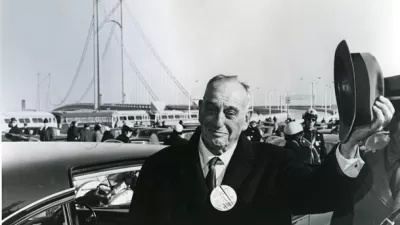Has historic preservation been responsible for making New York a luxury city? A former member of the city's Landmarks Preservation Commission argues no.
Roberta Brandes Gratz, author of The Battle For Gotham: New York in the Shadow of Robert Moses and Jane Jacobs, doesn't think landmarking deserves the bad rap it's received in some quarters.
"Critics of historic preservation make the egregious error of assuming that landmarking stops change, growth and other categories of 'progress.' They also mistakenly assume that it is the designation of these neighborhoods that make them increasingly expensive, forgetting that New York City has become a city for the rich and the poor for national and local economic reasons that have nothing to do with preservation."
The future, she says, is in density:
"For most of the 20th century, in fact until only recently, the planning and policy mantra has mistakenly been that de-densifying cities fights crime and poverty. Finally, recognition that the reverse is true is being recognized. De-concentrating poverty is not the same thing as de-densifying neighborhoods. Only the latter has long been happening with the new construction.
"It is indeed true, as preservation naysayers love to point out, that historic districts have become expensive but it is not because new excessively tall skyscrapers are not allowed; it is because these areas -- and many undesignated ones like them -- are considered the most desirable neighborhoods to live in."
Thanks to Matt Sledge
FULL STORY: Landmarking Urban Change in New York

Planetizen Federal Action Tracker
A weekly monitor of how Trump’s orders and actions are impacting planners and planning in America.

Maui's Vacation Rental Debate Turns Ugly
Verbal attacks, misinformation campaigns and fistfights plague a high-stakes debate to convert thousands of vacation rentals into long-term housing.

Restaurant Patios Were a Pandemic Win — Why Were They so Hard to Keep?
Social distancing requirements and changes in travel patterns prompted cities to pilot new uses for street and sidewalk space. Then it got complicated.

In California Battle of Housing vs. Environment, Housing Just Won
A new state law significantly limits the power of CEQA, an environmental review law that served as a powerful tool for blocking new development.

Boulder Eliminates Parking Minimums Citywide
Officials estimate the cost of building a single underground parking space at up to $100,000.

Orange County, Florida Adopts Largest US “Sprawl Repair” Code
The ‘Orange Code’ seeks to rectify decades of sprawl-inducing, car-oriented development.
Urban Design for Planners 1: Software Tools
This six-course series explores essential urban design concepts using open source software and equips planners with the tools they need to participate fully in the urban design process.
Planning for Universal Design
Learn the tools for implementing Universal Design in planning regulations.
Heyer Gruel & Associates PA
JM Goldson LLC
Custer County Colorado
City of Camden Redevelopment Agency
City of Astoria
Transportation Research & Education Center (TREC) at Portland State University
Jefferson Parish Government
Camden Redevelopment Agency
City of Claremont





























